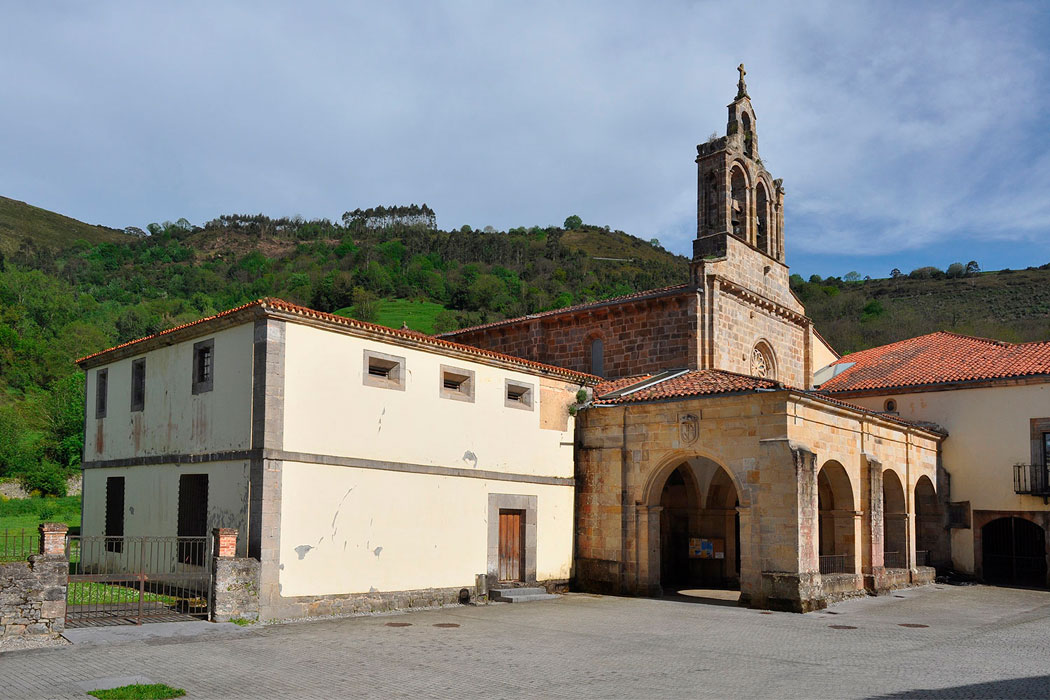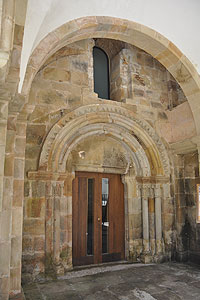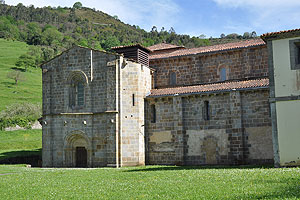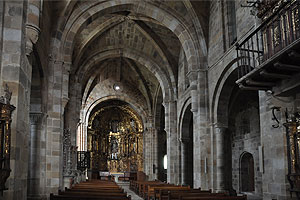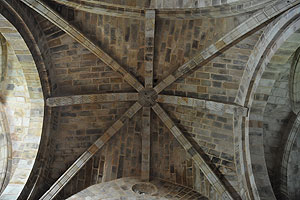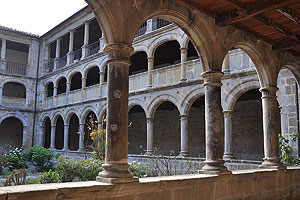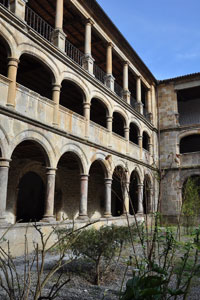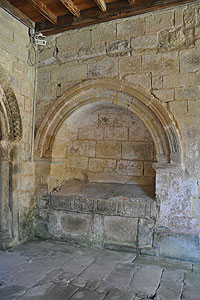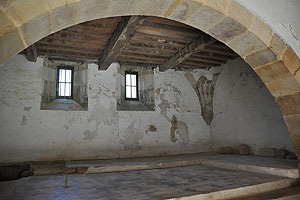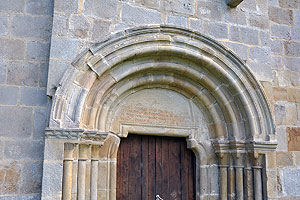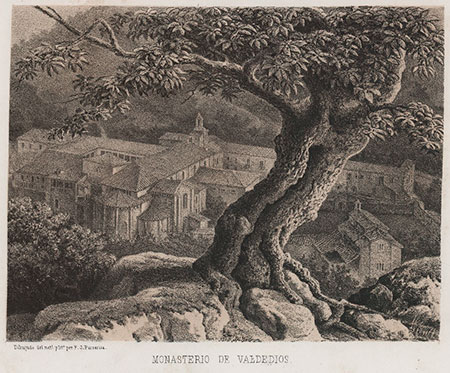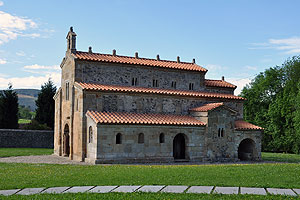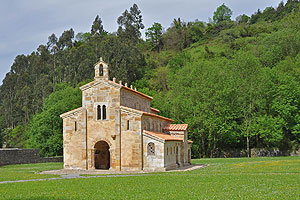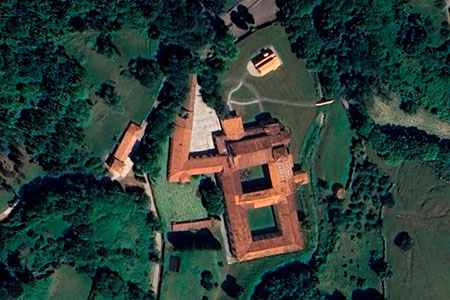Monastery of Santa María de Valdediós
Monasterio de Santa María de Valdediós / Boides / Valle Dei
(Villaviciosa, Asturias)
Santa María de Valdediós is a Cistercian foundation promoted by Alfonso IX of León (1171-1230) and his wife, Berenguela of Castile (1180-1246). It was formalized in the year 1200 in a document signed in Santiago de Compostela, through which the monarch ceded these lands, located in the place then known as Boiges, to the Cistercians from the monastery of Sobrado (La Coruña), with the aim of establishing a new monastery. In this place, there already existed, and still remains, a pre-Romanesque church dedicated to San Salvador.
Although there has been speculation about the existence of an ancient monastic community in this primitive church, it does not seem to have been the case. It is more likely that the church, consecrated in 893, was linked to a possible palace or royal domain. After the foundation, the monarch made several financial contributions and granted privileges to the new settlement, which gradually consolidated until, in 1210, Pope Innocent III placed it under his protection. Thanks to this boost, in 1218 Valdediós was able to begin the construction of a new church.
In 1225, the same king, and in 1232, Ferdinand III of Castile, issued documents confirming the monastery’s possessions. The increase in its holdings continued into the future until, by the 15th century, the monastery came under the control of commendatory abbots, who were largely detached from the activities within its walls. This situation ended when the monastery was integrated into the Cistercian Congregation of Castile, facilitating the recovery of the lost patrimony and initiating an ambitious construction project, carried out between the 16th and 18th centuries. However, the building suffered several episodes of flooding, as the monastery had been built on land reclaimed from the old course of a diverted river.
The events of the 19th century disrupted the Cistercian presence in Valdediós, first during the Peninsular War (1810-1811), then during the "Trienio Liberal", and finally with the exclaustration of 1835, when the community was expelled and the monastery and its lands were transferred to public ownership. In 1843, the monastery was put up for auction, but it was not sold, and some former monks continued to reside there for several years. After an attempt to re-establish a Cistercian community (1992-2009), since 2023 the monastery has been occupied by the community of La Presencia del Señor.
Affiliation of Valdediós
According to Originum Cisterciensium (L. Janauschek, 1877)Next to the monastery
- ÁLVAREZ MARTÍNEZ, María Soledad (2006). Consideraciones en torno al templo prerrománico de San Salvador de Valdediós. Liño. Revista anual de historia del arte, núm. 12
- GARCÍA ÁLVAREZ-BUSTO, Alejandro; ed. (2020). Asturias monástica. Catálogo de monasterios y revisión histórica arqueológica (siglos XI-XIX). Vol. 1. Anejos de Nailos n.º 7. Ovedo: KRK Ed.
- GARCÍA CUETOS, María Pilar (1992). El monasterio cisterciense de Santa María la Real de Valdediós. Datos para su estudio. Boletín del Real Instituto de Estudios Asturianos, núm. 139
- GARCÍA FLORES, Antonio (2013). El maestro Gualterio y Valdediós: notas sobre un maestro itinerante por los monasterios cistercienses del Reino de León durante el siglo XIII. Mosteiros cistercienses. Jorlis
- GARCÍA GUINEA, Miguel Ángel; dir. (2006). Enciclopedia del Románico en Asturias. Aguilar de Campoo. Fundación Santa María la Real
- JANAUSCHEK, Leopoldus (1877). Originum Cisterciensium. Vol. 1. Viena
- MANRIQUE, Angel (1649). Cisterciensium Annalium, Vol. 3. Lió: L. Anisson
- MARTÍNEZ VEGA, Andrés (2011). Monasterios medievales de Asturias. Oviedo: Cajastur, 2011
- QUADRADO, José María (1855). Recuerdos y bellezas de España. Asturias y León. Madrid: Repullés
- RISCO, Fray Manuel (1793). España Sagrada, Oviedo, vol. 38. Madrid: B. Román
- RUIZ DE LA PEÑA, Juan Ignacio; i altres (1012). La fundación del monasterio cisterciense de Santa María de Valdediós. Mundos medievales: espacios, sociedades y poder, vol. 1. Publican Ed.
- SOLANO FERNÁNDEZ-SORDO, Álvaro (2021). Santa María de Valdediós (Asturias) and its monastic family from foundation to reformation (1200-1515). Journal of Medieval Monastic Studies, núm. 10. Brepols
- VALDEDIÓS (1992). Monasterio cisterciense de Santa María de Vldediós
